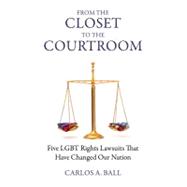
Carlos A. Ball is professor of law at the Rutgers University School of Law (Newark), has written extensively on LGBT rights issues, and is the author of The Morality of Gay Rights. He lives with his family in Brooklyn, New York.
| A Note from the Series Editor | p. ix |
| Introduction | p. 1 |
| Family | p. 21 |
| Harassment | p. 67 |
| Discrimination | p. 99 |
| Marriage | p. 151 |
| Sex | p. 199 |
| Conclusion | p. 249 |
| Where Are They Now? | p. 263 |
| Acknowledgments | p. 265 |
| Notes | p. 266 |
| Index | p. 275 |
| Table of Contents provided by Ingram. All Rights Reserved. |
The New copy of this book will include any supplemental materials advertised. Please check the title of the book to determine if it should include any access cards, study guides, lab manuals, CDs, etc.
The Used, Rental and eBook copies of this book are not guaranteed to include any supplemental materials. Typically, only the book itself is included. This is true even if the title states it includes any access cards, study guides, lab manuals, CDs, etc.